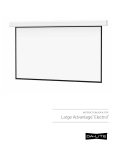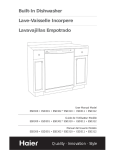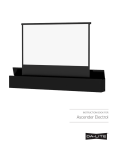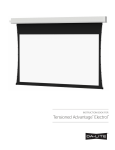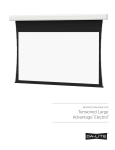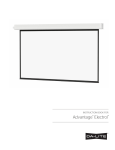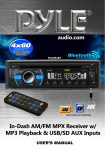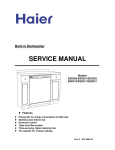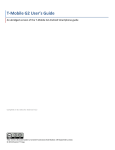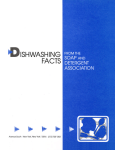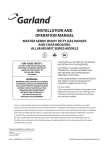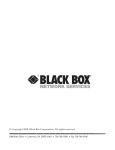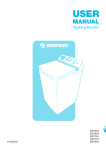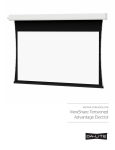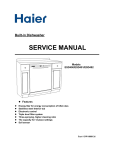Download 24" Built-In Dishwasher 24" Lave
Transcript
24" Built-In Dishwasher 24" Lave-Vaisselle Incorpere 24" Lavavajillas Empotrado Part # DW-9999-18 User Manual Guide de l'Utilisateur Manual del Usuario Modelo DWL4035DBWW • DWL4035DBBB • DWL4035MBSS Quality n Innovation n Style English SAFETY PRECAUTIONS Warning! – To reduce the risk of fire, electric shock, or injury to persons, always exercise basic safety precautions, including the following: 1. Read all instructions before using the appliance. 2. Use the dishwasher only for its intended function. 3. Use only detergents or rinse agents recommended for use in a dishwasher, and keep them out of the reach of children. 4. When loading items to be washed: 1) Locate sharp items so that they are not likely to damage the door seal; 2) Load sharp knives with the handles up to reduce the risk of cut-type injuries. 5. Do not wash plastic items unless they are marked "dishwasher safe” or the equivalent. For plastic items not so marked, check the manufacturer's recommendations. 6. Do not touch the heating element during or immediately after use. 7. Do not operate the dishwasher unless all enclosure panels are properly in place. 8. Do not tamper with controls. 9. Do not abuse, sit on, or stand on the door, lid, or dish racks of the dishwasher. 10. To reduce the risk of injury, do not allow children to play in or on the dishwasher. 11. U nder certain conditions, hydrogen gas may be produced in a hot water system that has not been used for two weeks or more. HYDROGEN GAS IS EXPLOSIVE. If the hot water system has not been used for such a period, before using the dishwasher turn on all hot water faucets and let the water flow from each for several minutes, This will release any accumulated hydrogen gas. As the gas is flammable, do not smoke or use an open flame during this time. 12. R emove the door or lid to the washing compartment when removing an old dishwasher from service or discarding it. SAVE THESE INSTRUCTIONS 1 English Thank you for purchasing our Haier product. This easy-to-use manual will guide you in getting the best performance from your Haier dishwasher. Remember to record the model and serial number. They are on a label in the dishwasher. Model number Serial number Date of purchase Staple your receipt to your manual. You will need it to obtain warranty service. 2 English Table Of Contents PAGE Safety Precautions ......................................................................1-2 Before Using Your Dishwasher ..............................................................4 Parts and Features ........................................................................6 Parts and Features ...............................................................................6 Start-up Guide.................................................................................7 Using Your New Dishwasher ................................................................7 Dishwasher Loading ..................................................................8-13 Loading Suggestions ............................................................................8 Loading Top Rack ...........................................................................9-10 Loading Bottom Rack ....................................................................11-12 Loading Silverware Basket ..................................................................13 Dishwasher Use .......................................................................13-23 Proper Use of Detergent .....................................................................14 Detergent Dispenser ......................................................................14-16 Rinse Aid Dispenser............................................................................17 Cycle Selection Charts ..................................................................18-19 Canceling a Cycle..............................................................................20 Changing a Cycle or Setting ..............................................................20 Adding Items During a Cycle ..............................................................21 Option Selections .........................................................................21-22 Cycle Status Indicators........................................................................23 Wash System.....................................................................................23 Drying System ...................................................................................24 Overfill Protection Float ......................................................................24 Washing Special Items ............................................................25-26 Dishwasher Care .....................................................................26-27 Cleaning .....................................................................................26-27 Drain Air Gap...................................................................................27 Storing..............................................................................................27 Troubleshooting .......................................................................28-31 Assistance or Service.....................................................................32 Warranty .......................................................................................33 3 English Before Using Your Dishwasher ! WARNING Tip Over Hazard • Do not use dishwasher until completely installed. • Do not push down on open door, doing so can result in serious injury or cuts. ! WARNING Electrical Shock Hazard • Electrically ground dishwasher. • Connect ground wire to green ground connector in terminal box. • Do not use an extension cord. • Failure to follow these instructions can result in death, fire, or electrical shock. • Install where dishwasher is protected from the elements. Protect against freezing to avoid possible rupture of fill valve. Such ruptures are not covered by the warranty. See "Storing" in the "Dishwasher Care" section for winter storage information. • Install and level dishwasher on a floor that will hold the weight and in an area suitable for its size and use. •R emove all shipping plugs from hoses and connectors (such as the cap on the drain outlet) before installing. See Installation Instructions for complete information. 4 English GROUNDING INSTRUCTIONS For a grounded, cord-connected dishwasher: The dishwasher must be grounded. In the event of a malfunction or breakdown, grounding will reduce the risk of electric shock by providing a path of least resistance for electric current. The dishwasher is equipped with a cord having an equipment- grounding conductor and a grounding plug. The plug must be plugged into an appropriate outlet that is installed and grounded in accordance with all local codes and ordinances. WARNING: Improper connection of the equipment-grounding conductor can result in a risk of electric shock. Check with a qualified electrician or service representative if you are in doubt whether the dishwasher is properly grounded. Do not modify the plug provided with the dishwasher; if it will not fit the outlet, have a proper outlet installed by a qualified electrician. For a permanently connected dishwasher: The dishwasher must be connected to a grounded metal, permanent wiring system, or an equipment- grounding conductor must be run with the circuit conductors and connected to the equipment- grounding terminal or lead on the dishwasher. 5 English Parts and Features 13 1 7 2 8 3 9 4 5 10 11 12 6 1. Upper Spray Arm 8. Middle Spray Arm 2. Top Rack Track 9. Removable Silverware Basket 3. Water Inlet Opening (in tub wall) 10. Overfill Protection Float 4. Lower Spray Arm 11. Heating Element 5. Bottom Rack 12. D etergent and Rinse Aid Dispenser 6. Vent System 7. Adjustable Upper Rack 13. Cup Shelf with Stem Guard (2) 6 English Start-up Guide Before using your dishwasher, remove all packaging materials. Read this entire Use and Care Guide. You will find important safety information and useful operating tips. USING YOUR NEW DISHWASHER 1. R inse aid is essential for good drying. Be sure to fill the dispenser before you use your new dishwasher. Each filling will last about 1 to 3 months depending on your usage. 2. S crape leftover food and hard items ( toothpicks or bones ) from dishes. You do not need to pre-rinse your dishes. 3. P roperly load the dishwasher. ( See" Dishwasher Loading" ) Load dishes with space in between so water will reach the soiled surfaces. Make sure nothing prevents the spray arm(s) from spinning freely.. 4. Add detergent. Always use a quality brand detergent. (See "Dishwasher Use") 5. Close the door. 6. P ress the desired cycle and option selections. The dishwasher starts filling when you press any cycle selection. You can select options as the machine fills. (See "Dishwasher Use") 7 English Dishwasher Loading LOADING SUGGESTIONS •R emove leftover food, bones, toothpicks and other hard items from the dishes To conserve water and energy and save time, it is not necessary to rinse dishes before putting them into the dishwasher. The wash system is designed to remove food particles from the water. The wash system includes a chopping device which will reduce size of food items. NOTE: If hard items such as fruit seeds, nuts, and eggshells enter the wash module, you might hear chopping, grinding, crunching, or buzzing sounds. These sounds are normal when hard items enter the module. Do not let metallic items (such as pot handle screws) get into the wash module. Damage can occur. • It is important for the water spray to reach all soiled surfaces. • L oad dishes so they are not stacked or overlapping if possible. For best drying results, water must be able to drain from all surfaces. • L oad heavy pots and pans carefully. Heavy items can dent the stainless steel interior of the door if they are dropped or bumped. •M ake sure pot lids and handles, pizza pans, cookie sheets, etc., do not interfere with the spray arm rotation. •C onserve water, energy and save time spent hand-rinsing by running a rinse cycle to keep dishes moist if you do not plan to wash them soon. Foods such as eggs, rice, pasta, spinach and cooked cereals may be hard to remove if they are left to dry over a period of time. QUIET OPERATING TIPS To avoid thumping/clattering noises during operation: • Make sure lightweight load items are secured in the racks. •M ake sure pot lids and handles, pizza pans, cookie sheets, etc., do not touch interior walls or interfere with the rotation of the spray arm. • Load dishes so they do not touch one another. NOTE: F or built-in models, keep sink drain plugs closed during dishwasher operation to prevent noise transfer through drains. 8 English LOADING TOP RACK The top rack is designed for cups, glasses and smaller items, Many items, up to 9 in. ( 22 cm ), fit in the top rack. ( See recommended loading patterns shown ) NOTE: T he features on your dishwasher rack may vary from the drawings shown. • Place items so open ends face down for cleaning and draining. • L oad glasses and cups in top rack only. The bottom rack is not designed for glasses and cups. Damage can occur. •P lace cups and glasses in the rows between tines. Placing them over the tines can lead to breakage and water spots. • T o avoid chipping, do not let stemware touch other items. Small bowls, pans and other utensils can be placed in the top rack. Load bowls in the center section for best stability. 9 English •C hina, crystal and other delicate items must not touch each other during dishwasher operation. Damage may occur. • L oad plastic items in the top rack only. Only plastic items marked "dishwashe safe" are recommended. • Load plastic items so the force of the spray does not move them during the cycle. CUP SHELF WITH STEM GUARD Fold down the extra shelf on the left or right side of the top rack to hold additional cups, stemware or long items such as utensils and spatulas. 10 English LOADING BOTTOM RACK The bottom rack is designed for plates, pans, casseroles, and utensils. Many items, up to 12.2 in. (31 cm) tall, fit in the bottom rack. (See recommended loading patterns shown) NOTE: T he features on your dishwasher rack may vary from the drawings shown. •D o not load glasses, cups, or plastic items in the bottom rack. Load small items in the bottom rack only if they are secured in place. • Load plates, soup bowls, etc. between tines. • Overlap the edges of plates for large loads. • L oad soup, cereal, and serving bows in the rack in a variety of ways depending upon their size and shape. Load bowls securely between the rows of tines. Do not nest bowls because the spray will not reach aIl surfaces. • L oad cookie sheets, cake pans, and other large items at the sides and back. Loading such items in front can keep the water spray from reaching the detergent dispenser 11 English • Secure heavily soiled cookware face down in the rack. •M ake sure pot handles and other items do not stop rotation of the spray arm(s). The spray arm(s) must move freely. •D o not load items between the bottom rack and the side of the dishwasher tub because they might block the water inlet opening. NOTE: S pin the spray arms. Be sure items in the basket do not stop the rotation of the spray arms. Fold-Down Rack You can fold down two rows of tines at the back of the bottom rack. 1. Grasp the tip of the tine that is in the tine holder. 2. Gently pull the tine out of the tine holder. 3. L ay the row of tines down in the rack to make room for larger dishes, bowls, pots, pans or roasters. 12 English LOADING SILVERWARE BASKET Load the silverware basket while it is in the bottom rack or remove the basket and place on a counter or table for loading. (See recommended loading pattern shown) NOTE: U nload or remove the basket before unloading the racks to avoid water drops from falling on the silverware. • L oad items with covers down, using the separators to prevent silverware nesting. •P lace small items such as baby bottle caps, jar lids, corncob holders, etc. in the section(s) with hinged cover(s). Close the cover to hold small items in place. •W hen covers are up, mix items in each section of the basket with some pointing up and some down to avoid nesting. Spray cannot reach nested items. IMPORTANT: Always load sharp items (knives, skewers, etc.) pointing down. Be sure that nothing protrudes through bottom of the basket or rack that may block the wash arm. NOTES: •D o not load silver or silver-plated silverware with stainless steel. These metals can be damaged by contact with each other during washing. •S ome foods (such as salt, vinegar, milk products, fruit juices, etc.), can pit or corrode silverware. Run a rinse cycle if you do not have a full load to wash immediately. 13 English Dishwasher Use PROPER USE OF DETERGENT Use only detergent specifically made for use in dishwasher. Cascade, Cascade Complete and Electrasol Automatic Dishwashing Detergents have been approved for use in all Haier dishwashers. Keep your detergent fresh and dry. Don't put powder detergent into the dispenser until you're ready to wash dishes. All wash cycles except RINSE ONLY require detergent in the main and pre-wash cup. Detergent Dispenser The detergent dispenser has 2 sections. The small Pre-Wash section empties detergent into dishwasher when you close the door. 1 3 2 1. 2. 3. 4. Cover latch Main Wash section Pre-Wash section Cover 4 The larger Main wash section automatically empties detergent into the dishwasher during the wash (See the "cycle Selection Charts") •U se automatic dishwashing detergent only. Other detergents can produce excessive suds that can overflow out of the dishwasher and reduce washing performance. • Add detergent just before starting a cycle. •S tore tightly closed detergent in a cool, dry place. Fresh automatic dishwasher detergent results in better cleaning. NOTE: Do not use detergent with a rinse cycle. Filling the dispenser 1. If the dispenser cover is closed, open the cover by pushing the cover latch. 14 English 2. Fill the Main Wash section with detergent. See "How much detergent to use." 3. Fill the Pre-Wash section, if needed. 4. Close the dispenser cover. It is normal for the cover to open partially when dispensing detergent. NOTE: U se both sections for cycles with 2 washes. Use only the main wash section for cycles with 1 wash, See the "Cycle Selection Charts" for more details. How much detergent to use • T he amount of detergent to use depends on the hardness of your water and the type of detergent. If you use too little, dishes won't be clean . If you use too much in soft water, glassware will etch. •D ifferent brands of dishwasher detergent have different amounts of phosphorous for softening water. If you have hard water and use a detergent with a phosphorous content of less than 8.7%, you might need to use more detergent, or use a detergent with a phosphorous content higher than 8.7%. 15 English Water Hardness Amount of Detergent Soft to Medium Hard Water For normally soiled loads 0 to 6 grains per gallon •P artially fill the Main Wash section with 4 tsp. •C ompletely fill the Pre-Wash section NOTE: F ill the Pre-Wash section halfway if dishes are pre-rinsed or the water is very soft (0 to 3.2/12 2 grains per gallon) For heavily soiled loads •P artially fill the Main Wash section with 6 tsp. • Completely fill the Pre-Wash section Medium to hard water For normal and heavily soiled loads 7 to 12 grains per gallon • Partially fill the Main Wash section with 6 tsp. • Completely fill the Pre-Wash section Very Hard Water For normally and heavily soiled loads 13 grains per gallon and above •C ompletely fill the main wash section NOTE: It might be necessary to use the Pots and Pans, or a normal cycle with Hi- Temp Scrub, for best wash performance with very hand water. • Completely fill the Pre-Wash section • T urn the rinse aid dispenser to a higher setting. See "Rinse Aid Dispenser" later in this section NOTE: Fill amounts shown are for standard powdered detergent. Amounts may vary if you use liquid or concentrated powdered detergent. Follow instruction on the package when using liquid dishwasher detergent or concentrated powdered detergent. If you use detergent tablets, use one whole tablet in the Main Wash section only for all loads and water hardness levels. 16 English RINSE AID DISPENSER Rinse aids prevent water from forming droplets that can dry as spots or streaks. They also improve drying by allowing water to drain off of the dishes during the final rinse by releasing a small amount of the rinse aid into the rinse water. Your dishwasher is designed to use a liquid rinse aid. Do not use a solid or bar-type. FILLING THE DISPENSER The rinse aid dispenser holds 4.8 oz ( 145ml ) of rinse aid. Under normal conditions, this will last for about three months. Rinse aid is released through an opening in the dispenser. You do not need to wait until the dispenser is empty to refill it. Try to keep it full, but be careful not to overfill it. 1. Make sure the dishwasher door is fully open. 2. Open the dispenser by pushing the cover latch. 3. Add rinse aid until the indicator window looks full. 4. Clean up any spilled rinse aid with a damp cloth. 5. Close the cover. RINSE AID SETTING The amount of rinse aid released into the final wash can be adjusted. The factory setting is at 2. For most water conditions, set the adjuster to 2 or 3. If there are rings or calcium ( hard water ) spots on dishes, try a higher setting. TO ADJUST THE SETTING Open the dispenser cover. Turn the adjuster inside the dispenser to the desired setting. 17 English CYCLE SELECTION CHARTS Select the wash cycle and options desired. The dishwasher starts filling once the door is closed and you press a cycle, unless you select a delay wash. After filling, and a brief wash period, the machine will pause for a 5 minute energy saving soak interval. During this time, dried and baked on soil is softened for easier removal later in the cycle. You can select options as the machine is filling. 5 where extra A "•"7shows what steps are in each6cycle. Temperatures indicate heat is added. Water usage is shown in U.S. gallons/liters. This model meets the ENERGY STAR® guidelines for energy efficiency. PANTONE�COOL GRAY 3C Cycle time does not include dry time. An asterisk (*) by the cycle time indicates PANTONE�427C the cycle time might be longer depending on the temperature of the water entering theDWL3525�WHITE�VERSION-160780101 dishwasher. E 7 D 7 6 6 Use for all soil types and dish loads. This cycle has additional checks for soil in the water to give added wash action time. The wash action will pause several times throughout the cycle, for up to 70 seconds, to check the soil level in the wash water. 5 5 4 4 PANTONE�COOL GRAY 3C PANTONE�COOL GRAY 3C PANTONE�427C PANTONE�427C DWL4035�WHITE�VERSION-160860101 DWL3525�WHITE�VERSION-160780101 DWL3525�WHITE�VERSION-160780101 61* C DWL7075�WHITE�VERSION 01 20 400 0 17 -160870101 DWL4035�WHITE�VERSION-160860101 DWL4035�WHITE�VERSION-160860101 B BACKGROUND:WHITE�COLOR DWL7075�WHITE�VERSION 012040 00 17 -160870101 DWL7075�WHITE�VERSION 0120 40 00 17 -160870101 T BUTTON�BACKGROUND:PANTONE�427C BUTTON TOP &�BOTTOM:PANTONE�COOL GRAY 3C FONTS:PANTONE�COOL GRAY 9C 18 English 5�WHITE�VERSION-160860101 PANTONE�COOL GRAY 3C PANTONE�427C WHITE�FROST(X1 160780101 TRANSPA 5�WHITE�VERSION 012040 00 17 -160870101 6 5 57* 4 3 160860101 PANTONE�COOL GRAY 3C PANTONE�427C WHITE�F VERSION-160780101 ACKGROUND:WHITE�COLOR UTTON�BACKGROUND:PANTONE�427C TRANSPARENT SMOKE 0120 40 00 17 -160870101 UTTON TOP &�BOTTOM:PANTONE�COOL GRAY 3C ONTS:PANTONE�COOL GRAY 9C SE EA EL CE R EEN PR FER LY RE E�ON US 37* ED:PANTONE�RED�1805C VERSION-160860101 ENTER�DESCRIPTION ED�WINDOW:WHITE�FROST. SEGMENT DISPLAY WINDOW:TRANSPARENT SMOKE 004/04/02 ITE�COLOR 6 5 4 OUND:PANTONE�427C TRANSPARENT S VERSION 0120 40 00 17 -160870101 TTOM:PANTONE�COOL GRAY 3C SE EA EL CE E-R REN R P LY FE RE E�ON US COOL GRAY 9C D�1805C QUALITY SYMBOLS 5 19 ACKGROUND:PANTONE�427C OP &�BOTTOM:PANTONE�COOL GRAY 3C 4 APPR: CH'KD: REV DESCRIPTION 1 OUND:WHITE�COLOR 6 =0 4�PLACES 3�PLACES C =0 2�PLACES 1�PLACE DRWN: heat and water as needed. AY WINDOW:TRANSPARENT SMOKE EC�NO: ENTER�DESCRIPTION • If the incoming water temperature is less than the recommended temperature or TE�FROST. food soils are heavy, the cycle will automatically compensate by adding time, GENE (UN 3 ANG DRAFT W MUST R WITHIN� English CANCELLING A CYCLE Anytime during a cycle, press Cancel Your dishwasher will start a 2-minute drain (if needed). Let the dishwasher drain completely. The light turns off after 2 minutes. NOTE: If your dishwasher does not need draining, press CANCEL again to turn the light turns off. Select a new cycle and options. To stop the drain You can press CANCEL again to stop the drain immediately. Remember to drain the dishwasher before starting a new cycle. To clear the indicators Press CANCEL before starting the dishwasher to clear all options and cycles. CHANGING A CYCLE OR SETTING During the first fill of a cycle 1. Press a new cycle and/or options. 2. Check the detergent dispensers.They must be filled properly for the new cycle. After the first fill of a cycle 1. Press Cancel Your dishwasher will start a 2-minute drain (if needed). Let the dishwasher drain completely. The light turns off after 2 minutes. NOTE: If your dishwasher does not need draining,press CANCEL again to turn the light off. 1. Check the detergent dispensers. They must be filled properly for the new cycle. 2. Press a new cycle and/or options. 20 ADDING ITEMS DURING A CYCLE You can add an item anytime before the main wash starts. Open the door and check the detergent dispenser If the cover is still closed, you can add items. To add items 1. O pen the door slightly. Wait for the spraying action to stop before opening the door completely. 2. Open the door. If the detergent dispenser cover is still closed, add the item. 3. C lose the door firmly until it latches. The dishwasher resumes the cycle after about a 10-15 second pause. OPTION SELECTIONS You can customize your cycles by pressing an option. If you change your mind, press the option again to turn the option off. Select a different option if desired. You can change an option anytime before selected option begins. For example, you can press an unheated drying option anytime before drying begins. Hi-Temp Wash Select this option to heat the water during parts of the cycle. Higher water temperatures helps clean tough soils. Hi-Temp Wash, with the Pots & Pans or Normal cycles, raises the water temperature in the main wash. This option adds heat, water and wash time to a cycle. 11 NOTE: H i-Temp Wash is an option with the Pots & Pans and Normal cycles. Always use Hi-Temp Wash if you have hard water. Sanitize Rinse Option Select this option to raise the water temperature in the final rinse to approximately 160 F ( 71°C ). The Sanitize Rinse Option adds heat and time to the cycle. This high temperature rinse sanitizes your dishes and glassware in accordance With NSF/ANSI standard 184 for Residential dishwasher. Certified residential dishwasher are not intended for licensed food establishments. NOTE: S anitize Rinse is an option with the Pots & Pans and Normal cycle. Only these sanitization cycles have been designed to meet the NSF/ANSI requirements. 21 HEATED DRY Select this option to dry dishes with heat. Not selecting heated dry skips the drying period. If the heated drying period is not selected the dishes take longer to dry and some spotting can occur. For best drying, always use a liquid rinse aid. Some items (such as plastics) may need towel drying. NOTE: H eated Dry is an option with Pots and Pans Wash, Normal and Light cycles. For faster air drying, you can open the door a couple of inches after the final rinse is complete. STEAM OPTION Use for all dish loads, including extra large loads. Steam is generated early in the cycle to help wet baked on soils from dish load and soften it for easier removal by the wash system. The steam cycle raises the temperature in the final rinse to 150ºF (66ºC). NOTE: This option can be used with all cycles except Rinse Only and Speed Wash. DELAY HOURS Select this option to run your dishwasher at a later time or during off-peak hours. You can add items to the load anytime during the delay countdown. After adding items, close the door firmly until it latches. You can delay the start of a cycle up to 9 hours. To delay the start: 1. Open the door 2. R epeatedly press "Delay Hours" until you see the desired hours of delay lighted in LED indicator on the left. When the delay reaches 12 hours, the delay turns off. Press "Delay Hours" again to select a new number of delay hours. 3. Select a wash cycle and options 4. Close the door NOTE: T o cancel the delay and cycle, press Cancel. To cancel the delay and start the cycle immediately, press "Delay Start" until there is no light in any of the LED indicators on the left. 22 English CYCLES STATUS INDICATORS Follow the progress of your dishwasher with the Cycle Status indicators. Sensing Sensing light glows during the sensing parts of the cycle. Your dishwasher senses soil levels at various times during the dishwasher cycle. Washing pauses, while sensing occurs. Washing Displayed during pre-wash and main wash periods. Rinsing Displayed during rinse periods. Drying Lights up when the dishwasher is drying after the final rinse. Sanitized Displayed when cycle has met sanitization conditions. The light will remain ON until door is opened. Wash System An energy saving soak interval is used for most cycles shortly after the initial water fill. During the 5 minutes of soaking, dried and baked on food is loosened without using energy. Later in the cycle the robust wash action removes the softened food more efficiently. The six-level wash system provides excellent cleaning results. Three levels of filtration and a soil collector system filter the wash water and prevent food particles from redepositing on the clean dishes. 23 English • The wash water continuously flows through the filter, trapping food particles. • T wo water jets, located under the spray arm, remove the food particles from the filter. •A coarse strainer prevents bones, pits, and other large objects from entering the pump system. NOTE: P eriodically check the bottom of the tub and remove any objects on the strainer. Drying System During drying, you can see hot vapor escaping through the vent at the upper left corner of the door.This is normal as the heat dries your dishes. IMPORTANT: The vapor is hot. Do not touch the vent. Overfill Protection Float The overfill protection float (in the front right corner of the dishwasher tub) keeps the dishwasher from overfilling. It must be in place for the dishwasher to operate. Check under the float for objects that may keep the protector from moving up or down 24 English Washing Special Items If you have doubts about washing a particular item, check with the manufacturer to see if it is dishwasher safe. Material Dishwasher Safe / Comments Aluminum Yes High water temperature and detergents can affect finish of anodized aluminum. Disposable Aluminum No Do not wash disposable aluminum pans in the dishwasher These might shift during washing and transfer black marks to dishes and other items. Bottles and cans No Wash bottles and cans by hand. Labels attached with glue can loosen and clog the spray arms or pump and reduce washing performance. Cast Iron No Seasoning will be removed and iron will rust. China / Stoneware Yes Always check manufacturer's recommendations before washing. Antique, hand-painted, or over-the-glaze patterns may fade, gold leaf can discolor or fade. Crystal Yes Check manufacturer's recommendations before washing. Some types of leaded crystal can etch with repeated washing. Gold No Gold-colored flatware will discolor Glass Yes Milk glass yellows with repeated dishwasher washing. Hollow-Handle Knives No Handles of some knives are attached to the blade with adhesives which can loosen if washed in the dishwasher. Pewter Brass, Bronze 25 No High water temperatures and detergent can discolor or pit the finish. English Material Dishwasher Safe / Comments Disposable Plastics No Cannot withstand high water temperatures and detergents. Plastics Yes Always check manufacturer's recommendations before washing. Plastics vary in their capacity to withstand high temperatures and detergents. Load plastics in top rack only. Stainless Steel Yes Run a rinse cycle if not washing immediately. Prolonged contact with food containing salt, vinegar, milk products, or fruit juice can damage finish. Sterling Silver or Silver Plate Yes Run a rinse cycle if not washing immediately. Prolonged contact with food containing salt, acid, or sulfide (eggs, mayonnaise, and seafood) can damage finish. Tin No Can rust. Wooden Ware No Wash by hand. Always check manufacturer's instructions before washing. Untreated wood can warp, crack, or lose its finish. DISHWASHER CARE Cleaning Cleaning the exterior In most cases, regular use of a soft, damp cloth or sponge and a mild detergent is all that is necessary to keep the outside of your dishwasher looking nice and clean. Cleaning the interior Hard water minerals can cause a white film to build up on the inside surfaces, especially just beneath the door area. Do not clean the dishwasher interior until it has cooled. Wear rubber gloves. Do not use any type of cleanser other than dishwasher detergent because it may cause foaming or create suds. 26 English To clean interior Make a paste with powdered dishwasher detergent on a damp sponge and clean. OR Use liquid automatic dishwasher detergent and clean with a damp sponge. OR See the vinegar rinse procedure in "spotting and filming on dishes" in "Troubleshooting." NOTE: Run a Normal cycle with detergent after cleaning the interior. DRAIN AIR GAP Check the drain air gap anytime your dishwasher isn't draining well. Some state or local plumbing codes require the addition of a drain air gap between a builtin dishwasher and the home drain system. If a drain is clogged, the drain air gap protects your dishwasher from water backing up into it. The drain air gap is usually located on top of the sink or countertop near the dishwasher. NOTE: The drain air gap is an external plumbing device that is not part of your dishwasher. The warranty provided with your dishwasher does not cover service costs directly associated with the cleaning or repair of the external drain air gap. To clean the drain air gap Clean the drain air gap periodically to ensure proper drainage of your dishwasher. Follow the cleaning instructions provided by the manufacturer. With most types: Lift off the chrome cover. Unscrew the plastic cap. Check for any soil buildup. Clean if necessary. STORING Storing for the Summer Protect your dishwasher during the summer months by turning off the water supply and power supply to the dishwasher. Winterizing your dishwasher Protect your dishwasher and home against water damage caused by freezing water lines. If your dishwasher is left in a seasonal dwelling or could be exposed to near freezing temperatures, have your dishwasher winterized by authorized service personnel. 27 English Troubleshooting Try the solutions suggested here first and possibly avoid the cost of a service call... DISHWASHER IS NOT OPERATING PROPERLY •D ishwasher does not run or stops during a cycle It is normal for most cycles to pause for 5 minutes near the start of a cycle to let the dishes soak. This reduces energy required to clean the dishes. Is the door closed tightly and latched? Is the right cycle selected? Refer to the Cycle Selection charts. Is there power to the dishwasher? Has a household fuse blown or circuit breaker tripped? Has the motor stopped due to an overload? The motor automatically resets itself within a few minutes. If it does not restart, call for service. Is the water shut-off valve (If installed) turned on? Is it normal for certain cycles to repeatedly pause for 15 to 65 seconds during the main wash. •D ishwasher will not fill Is the overfill protection float able to move up and down freely? Press down to release. •D ishwasher seems to run too long Is the water supplied to the dishwasher hot enough? The dishwasher runs longer while heating water Refer to the "Dishwasher Performance Tips" section. A delay automatically occurs in some wash and rinse cycles until the water reaches the proper temperature. • Water remains in the dishwasher Is the cycle complete and not in a pause? It is normal to have a small amount of clean water around the outlet in the bottom of the tub, to keep the water seal lubricated. If the drain hose is connected to a food waste disposer, make sure the dispenser is empty. Make sure the knockout plug has been removed from the food waste disposer. Check to see if the drain hose is kinked. •D etergent remains in the covered section of the dispenser Is the cycle complete? Is the detergent lump-free? Replace detergent if necessary. Was a dish item blocking the dispenser? •W ater residue on the front of the access panel Was too much detergent used? Refer to the "Detergent Dispenser" section. Is the brand of detergent making excess foam? Try a different brand to reduce foaming and eliminate buildup. •O dor in the dishwasher Are dishes washed only every 2 or 3 days? Run a rinse cycle once or twice a day until you have a full load. Does the dishwasher have an unpleasant smell? Run a vinegar rinse as described in "Spotting and filming on dishes" later in this troubleshooting guide. •C ondensation on the kitchen counter (built-in models) Is the dishwasher aligned with the countertop? Moisture from the vent in the dishwasher console can form on the counter. Refer to the lnstallation Instructions for more information. 28 English Dishes are not completely clean •F ood soil left on the dishes Is the dishwasher loaded correctly? Refer to the "Dishwasher Loading" section. Did you choose the cycle that describes the most difficult soil in your dishwasher? lf you have some items with heavier soils, use a heavier cycle. Is the water temperature too low? For best dishwashing results, water should be 120ºF (49 ºC) as it enters the dishwasher. Refer to the "Dishwasher Performance Tips" section. Did you use the correct amount of fresh detergent? Use recommended dishwasher detergents only. Refer to the "Detergent Dispenser " section. Never use less than 1 tb (15g) per load. Detergent must be fresh to be effective. Store detergent in a cool, dry area Heavy soil and/or hard water generaily require extra detergent. Is detergent caked in dispenser? Use fresh detergent only. Do not allow detergent to sit for several hours in a wet dispenser. Clean dispenser when caked detergent is present. Is the pump or spray arm clogged by Iabels from bottles and cans? If you wash bottles and cans in your dishwasher, check for labels clogging the pump or spray arm. Is the home water pressure high enough for proper dishwasher filling? Home water pressure should be 20 to 120 psi (138 to 828 kPa) for proper dishwasher fill. A booster pump on the water supply can be added if pressure is too low. Are high suds slowing the wash arm? Never use soap or laundry detergents. Use recommended dishwasher detergents only. SPOTS AND STAINS ON DISHES •S potting and filming on dishes Is your water hard or is there a high mineral content in your water? Conditioning the final rinse water with a liquid rinse aid helps eliminate spotting and filming. Keep the rinse aid dispenser filled. Always use a high-temp option. If your water hardness is 13 grains or above, it is strongly recommended that you install a home water softener if you do not wish to drink softened water, have the softener installed onto your hot water supply. Is the water temperature too low? For best dishwashing results, water should be 120ºF (49ºC) as it enters the dishwasher. Refer to the "Dishwasher Performance Tips" section. Did you use the correct amount of effective detergent? Use recommended dishwasher detergents only. Refer to the "Detergent Dispenser" section. Never Use less than 1 tb (15g) per load. Detergent must be fresh to be effective. Store detergent in a cool, dry area. Heavy soil and/or hard water generally require extra detergent. 29 English Is the home water pressure high enough for proper dishwasher filling? Home water pressure should be 20 to 120 psi ( 138 to 828 kpa ) for proper dishwasher fill. A booster pump on the water supply can be added if pressure is too low. NOTE: To remove spots and film from dishes, try a white vinegar rinse. This procedure is intended for occasional use only vinegar is an acid and using it too often could damage your dishwasher. 1. W ash and rinse dishes. Use an air-dry or an energy saving dry option. Remove all silverware or metal items. 2. P ut 2 cups ( 500 mL ) white vinegar in a glass or dishwasher-safe measuring cup on the bottom rack. 3. R un the dishwasher through a complete washing cycle using an air-dry or an energy saving dry option. Do not use detergent. Vinegar will mix with the wash water. •S ilica film or etching (silica film is a milky, rainbow-colored deposit; etching is a cloudy film) Sometimes there is a water/chemical reaction with certain types of glassware. This is usually caused by some combination of soft or softened water, alkaline washing solutions, insufficient rinsing, overloading the dishwasher, and the heat of drying. It might not be possible to prevent the problem, except by hand washing. T o slow this process use a minimum amount of detergent but not less than 1 tb (15 g) per load. Use a liquid rinse aid and under load the dishwasher to allow thorough rinsing. Silica film and etching are permanent and cannot be removed. Do not use heated drying. •W hite spots on cookware with non-stick finish Has the dishwasher detergent removed cookware seasoning? Reseason cookware after washing in the dishwasher. •B rown stains on dishes and dishwasher interior Does your water have high iron content? Rewash dishes Using 1 - 3 tsp (5-15 ml) of citric acid crystals added to the covered section of the detergent dispenser .Do not use detergent. Follow with a Normal wash cycle with detergent. If treatment is needed more often than every other month, the lnstallation of an iron removal unit is recommended. •B lack or gray marks on dishes Are aluminum items rubbing dishes during washing? Disposable aluminum items can break down in the dishwasher and cause marking, Hand wash these items. Remove aluminum markings by using a mild abrasive cleaner. •O range stains on plastic dishes or dishwasher interior Are large amounts of tomato-based foods on dishes placed in the dishwasher? It may be necessary to use a stain removal product to remove stains from your dishwasher.Stains will not affect dishwasher performance. 30 English DISHES DO NOT DRY COMPLETELY •D ishes are not dry Did you load your dishwasher to allow proper water drainage? Do not overload. Refer to the "Dishwasher Loading" section. Use a liquid rinse aid to speed drying. Are the plastics wet? Plastics often need towel drying. Is the rinse aid dispenser empty? Refer to the "Rinse Aid Dispenser" section. id you use an air-dry or energy-saving dry option? Use a heated drying D option for dryer dishes. DISHES ARE DAMAGED DURING A CYCLE •C hipping of dishes Did you load the dishwasher properly? Load the dishes and glasses so they are stable and do not strike together from washing action. Minimize chipping by moving the rack in and out slowly. NOTE: A ntiques, feather-edged crystal, and similar types of china and glassware might be too delicate for automatic dishwashing. Wash by hand. NOISES •G rinding, grating, crunching or buzzing sounds A hard object or powder detergent granulates have entered the wash module. When the object is ground up, the sound should stop. 31 English Assistance or Service Before calling for assistance or service, please check "Troubleshooting". It may save you the cost of a service call. If you still need help follow the instructions below. When calling, please have the purchase date and the complete model and serial number of your appliance. This information will help us to better respond to your request. If you need replacement parts If you need to order replacement parts, we recommend that you only use factory specified parts. These parts will fit right and work right. To locate factory specified replacement parts in your area, call our Customer Interaction Center telephone number ( 1-877-337-3639 ) or your nearest designated service center 32 English Limited Warranty In-Home Service 1 Year Warranty For 12 months from the date of original retail purchase, Haier will repair or replace any part free of charge that fails due to a defect in materials or workmanship, including labor. 3 Years Limited Warranty (Parts Only) For 36 months from the date of original retail purchase, Haier will provide a replacement part free of charge for any part which fails due to manufacturing defect. Stainless Steel Tub and Door Liner The Stainless steel tub and door liner are warranted for the life of the dishwasher for rust through. NOTE: A ssociated external inlet water and drain plumbing parts are not covered by this warranty. Exceptions: Commercial or Rental Use Warranty 90 days labor from date of original purchase 90 days parts from date of original purchase No other warranty applies For Warranty Service Contact your nearest authorized service center. All service must be performed by a Haier authorized service center. For the name and telephone number of the nearest authorized service center please call 1-877-337-3639. Before calling, please have the following information available: Model number and serial number of your appliance (found on the left side of door opening). The name and address of the dealer you purchased the unit from and the date of purchase. A clear description of the problem. A proof of purchase (sales receipt). 33 This warranty covers appliances within the continental United States, Puerto Rico and Canada. What is not covered by this warranty: Replacement or repair of household fuses, circuit breakers, wiring or plumbing. A product whose original serial number has been removed or altered. Any service charges not specifically identified as normal such as normal service area or hours. Damage to dishware. Damage incurred in shipping. Damage caused by improper installation or maintenance. Damage from misuse, abuse accident, fire, flood, or acts of nature. Damage from service other than an authorized Haier dealer or service center. Damage from incorrect electrical current, voltage or supply. Damage resulting from any product modification, alteration or adjustment not authorized by Haier. Adjustment of consumer operated controls as identified in the owners manual. Hoses, knobs and all attachments, accessories and disposable parts. Labor, service transportation, and shipping charges for the removal and replacement of defective parts beyond the initial 12-month period. Damage from anything other than normal household use. Any transportation and shipping charges. THIS LIMITED WARRANTY IS GIVEN IN LIEU OF ALL OTHER WARRANTIES, EXPRESSED OR, INCLUDING THE WARRANTIES OF MERCHANTABILITY AND FITNESS FOR A PARTICULAR PURPOSE The remedy provided in this warranty is exclusive and is granted in lieu of all other remedies. This warranty does not cover incidental or consequential damages, so the above limitations may not apply to you. Some states do not allow limitations on how long an implied warranty lasts, so the above limitations may not apply to you. This warranty gives you specific legal rights, and you may have other rights, which vary, from state to state. Haier America New York, NY 10018 IMPORTANT Do Not Return This Product To The Store If you have a problem with this product, please contact the “Customer Satisfaction Center” at 1-877-337-3639. DATED PROOF OF PURCHASE REQUIRED FOR WARRANTY SERVICE IMPORTANT Ne pas Réexpédier ce Produit au Magasin Pour tout problème concernant ce produit, veuillez contacter le service des consommateurs ‘Customer Satisfaction Center’ au 1-877-337-3639. UNE PREUVE D’ACHAT DATEE EST REQUISE POUR BENEFICIER DE LA GARANTIE. IMPORTANTE No regrese este producto a la tienda Si tiene algún problema con este producto, por favor contacte el “Centro de Servicio al Consumidor” al 1-877-337-3639 (Válido solo en E.U.A). NECESITA UNA PRUEBA DE COMPRA FECHADA PARA EL SERVICIO DE LA GARANTIA 115V, 60 Hz Made in China Fabriqué en Chine Hecho en China Haier New York, NY 10018 Printed in China v1: Issued September 2009 v2: Issued June 2010 DWL4035 © 2010 Haier America Trading, LLC. All Rights Reserved. 101092





































